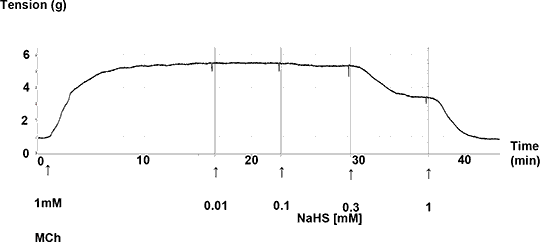Effects of Hydrogen Sulphide on the Human Pulmonary Vasculature and Airways Background There is currently growing interest in the therapeutic potential of hydrogen sulphide (H2S) in numerous pathologies including cardiovascular and respiratory disease (1-3). The aim of this study was to investigate the effects of H2S on human pulmonary vascular and airway tone for the first time. Methods Rings of human pulmonary arteries, veins and bronchi were obtained at resection for cancer and mounted in organ baths to measure isometric tension. The effects of H2S on resting tension and to maximum active tension to 3 nM endothelin-1 (pulmonary arteries), 1 nM endothelin-1 (pulmonary veins) and 1 mM methacholine (MCh) (bronchi) were determined by cumulative addition of sodium hydrogen sulphide (NaHS) to the organ baths. Results NaHS caused a robust, concentration dependent (0.1-3 mM) and reversible relaxation of human pulmonary arteries (n=8), veins (n=8) and bronchi (n=14) from resting and active tension (Table 1). In human bronchi the Emax of relaxation to NaHS was greater than the Emax for relaxation to the full β-adrenoceptor agonist isoprenaline (10 µM) obtained in unpaired control preparations (-120 ± 43 vs. -93 ± 39 % reversal of cholinergic contraction for NaHS (n=14) and isoprenaline (n=34) respectively, mean ± SD, p = .31 via unpaired t-test). Figure 1 is an experimental trace showing the concentration dependent relaxation of a human bronchus to NaHS from active tension to 1 mM methacholine. Table 1. EC50 [mM] (mean ± SD) for NaHS from resting and active tension in human pulmonary arteries, veins and bronchi
Figure 1. Experimental trace showing concentration dependent relaxation of a human bronchus to NaHS from maximum active tension to 1 mM methacholine (MCh) Summary In this study it has been shown for the first time that H2S causes a robust, concentration dependent and reversible relaxation of the human pulmonary vasculature and airways and further studies are needed to determine the mechanism mediating relaxation to H2S. The therapeutic potential of H2S in treating pulmonary vascular disease, such as pulmonary hypertension and constrictive airway diseases such as COPD and asthma warrants further investigation. (1) Olson KR (2011). Am J Physiol-Reg I 301: R297-312. (2) Whiteman M et al. (2011). Clin Sci 121: 459-88. (3) Wang R (2012). Physiol Rev 92: 791-896. |
||||||||||||||||


